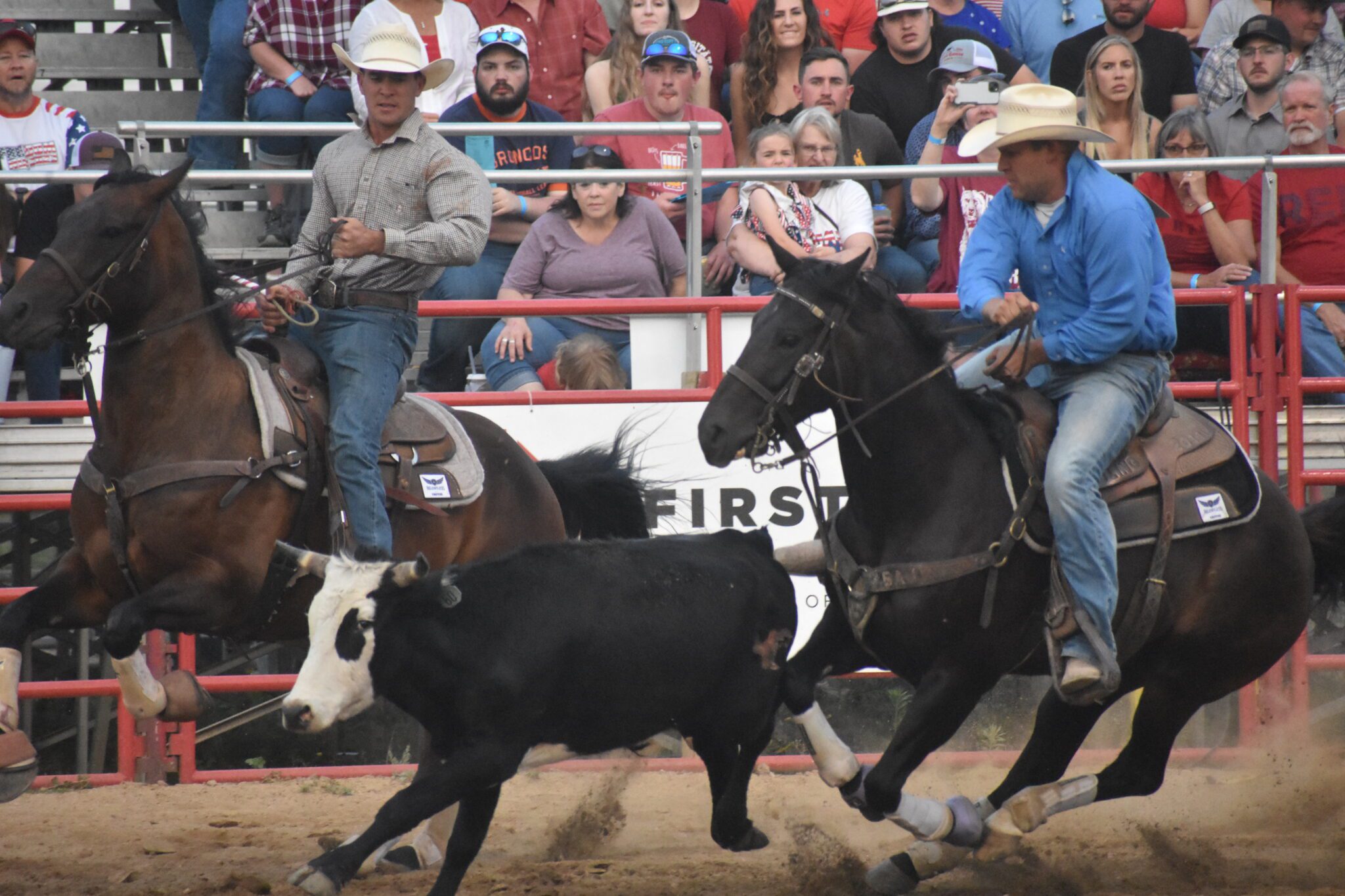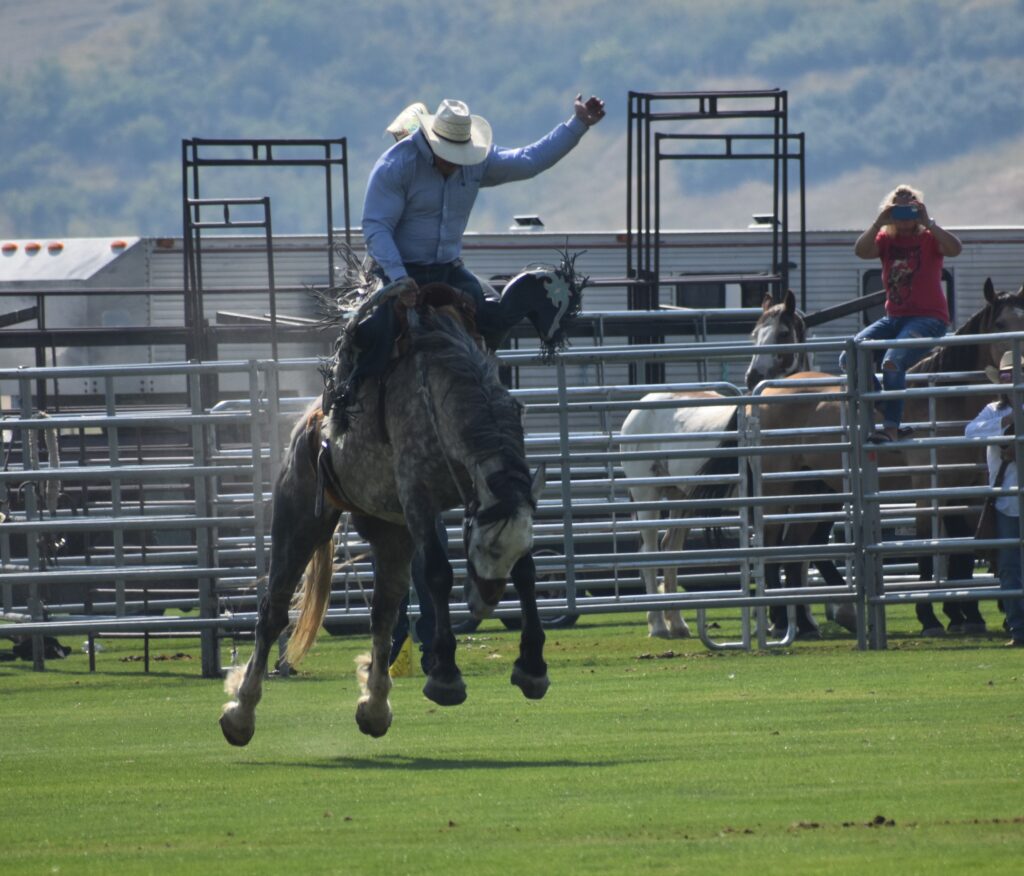News
A Little Rodeo History

WYO Rodeo Week is almost here! Today, we take a look back at how rodeo got its start.
The word ‘rodeo’ is taken from the Spanish ‘rodeo’ pronounced ro-dee-oh. As many cowboys were Mexican or Mexican American, the Spanish words worked their way into the ranching lingo. Chaps, shortened from chaparreras; lasso, from the Spanish lazo; lariat, from la reata and several others.
The first noted use of the term rodeo used in English was in 1834 to refer to a cattle roundup.
Today, rodeo is a competitive equestrian sport. Most of the events, calf roping, steer roping, and bronc riding, are a direct echo of the range cattle culture.
During the open range era, cattle were not corralled, but they were gathered, branded and doctored on the un-fenced ranges. Horses and riders acted like the fence to keep the cattle contained while branding and sorting. Even today, on many ranches, calves are roped and wrestled to the ground to be branded. Unlike calf roping in rodeos, where calves are caught around the neck, ropers at the brandings usually ‘heel’ or catch the calves by the back feet, making it easier for the wrestlers.
The event of team roping, where one cowboy ropes the full-grown steer around the horns, and another ropes the heels, evolved from having to brand or doctor full-grown animals on the range.

Bronco riding comes from the old process of breaking horses. Horses ran wild until they were four or five years old, then the ‘bronc stomper’ would rope the horse, snub him to a post, possibly even tie a blindfold over the horses’ eyes, throw a saddle and hackamore on him, untie him from the post, and swing aboard. After the horse found he could not throw the rider, he settled down and was ready to be taught lessons necessary to become a cow horse.
Bull riding and bull dogging were not essential ranch skills, but bull dogging, dropping off the horse, grabbing the steers horns and wrestling it to the ground, was invented by a black Texas cowboy, William M. Pickett. In 1971, he became the first African-American honoree to be named in the National Cowboy Hall of Fame
Cheyenne Daily Leader, October 1904 and the Wyoming Semi-Weekly Tribune, September 1904 talk about William Pickett, “a Texas negro, performed his wonderful feat of catching a wild steer by the nose with his teeth and throwing the animal on its back.”
“William Pickett, the Taylor, Texas man who performs a feat unrivaled in its sensational aspects by anything heretofore attempted. Pickett is not a big man but is built I like an athlete and his feat will undoubtedly be one of the great features of this year’s celebration. It is difficult to conceive how a man could throw a powerful steer with his bands unaided by ropes or a contrivance of some kind and yet Pickett accomplishes this seemingly impossible task with his teeth alone.
Although Pickett did throw some bulls with his teeth, he also wrestled them to the ground by grabbing the horns, like the steer wrestlers do today.
The Cheyenne Frontier Days is known as the “Daddy of them All” and started in 1897. This from The Sheridan Post, July 21, 1920 –Frontier Days at Cheyenne Promises to Break All Former Records. Cheyenne, Wyo., July 20.—The historic Frontier Day celebration for which preparations are now practically complete is expected to prove the greatest of all the 24 annual presentations of the rodeo, which will be held this year on July 27th-30th in Cheyenne. Heralded throughout the county by “Miss Wyoming” who acts‘ as the messenger of Governor Robert D, Carey, the celebration this year has attracted the attention of many notables who have not only acted the invitations to attend Frontier Days, but also will remain longer to see the modern west as contrasted with the early days revived at Cheyenne. Frontier Days this year will be more representative of the cattle land that is passing than of the professional wild west of the flickering screen. New contests typifying the work of the open range have been added to the program, or used to substitute some of the former, events, notably a few running races.
All of the spectacular relay races using thoroughbred horses have been retained but in addition a regular cowmen’s relay in which the rider must stop, catch a fresh horse from the herd in the corral after each lap, has been added.
Cutting out marked cattle from a herd just as it is done on the range when a roundup is in progress will be another feature of marked interest. This part of the program will give each contestant an opportunity to show his real skill in range work and will also give the visitor who has never witnessed the swirling dust clouds and rapid action of a cattle roundup a chance to see how the work is done and “what it is all about,”
The major event which is contested on all four days is the broncho busting for the championship of the world. Keen competition is promised the coveted honors now held by Eddie McCarty of Goldsmith, Wyoming, some remarkable riders having developed in smaller preparatory roundups throughout the west, and many former title holders returning another try. The contest carries a $1,500.00 purse and the $500.00 silver mounted Union Pacific saddle, presented by Vice President E. E. Calvin of the big railroad system. In addition to the broncho busting, the bulldogging and the steer roping contests also carry world’s championship titles.

The cowgirls’ relay race will be among the most thrilling of the contests, especially as the winning of the famous McAlpin trophy presented by L. M. Boomer, multi-millionaire hotel magnate of New York, carries with it a trio to the metropolis and a week’s entertainment there. In addition to the McAlpin trophy and it’s attendant trip, a large purse is hung up for the lucky girl winner.
The Arapahoe Indians from Western Wyoming will be at Frontier Days in force, (and will give) one of the most remarkable performances ever given by Indians before the white people will be seen in the Arapaho fire Dance, which they plan to stage on the flat prairie north of Cheyenne on one evening of the celebration.

Early day rodeos had many more events that most of today’s rodeos. They were often more reflective of the range culture as well. Races, relay, horse races and even auto races, were a big part of the rodeo, or Stampede as it was sometimes called.
The Sheridan Post September 7, 1915, advertised the rodeo. – Greatest Aggregation Performers Ever Seen. Riders and Ropers From all the West are Here for the Stampede. Whatever else may befall, the Sheridan Stampede for 1915 will be notable for this one thing: It will see the greatest gathering of champion wild west performer ever gathered together in one town. No exceptions That statement is made in all sincerity and without, as the lawyers say, fear of successful contradiction.
Never before has there been such a gathering of champion wild west performers in one town. They are here from every western state from Mexico and from Canada They are bound for most any old place. Pendleton, Walla Walla, Calgary, Douglas, south, north east and west but they are here now and will be here until the Stampede is over.
Here is a partial list, made up Sunday afternoon, of those who have arrived and registered at Stampede headquarters Everyone is entered (or some event of the Stampede: Lucille Mulhall. world champion cowgirl steer roper; Vera McGinnis. champion all around cowgirl; Iva Mulhall. Cowgirl stenographer as well as rider; Georgia Mulhall, high school horse rider; Louise Thompson bucking horse and relay rider; Arlo Weaver, relay rider; Mrs Ed Wright, champion bucking horse rider in the world; Minnie Thompson, bucking horse rider; Vera Parker, pony express; Ruth Seales race rider; Red Parker, bronco rider, steer rider and bareback rider; Homer S. Wilson range boss of the Wild Bunch; Tommy Grimes, bronco and trick rider; Charles Mulhall, champion bulldogger and bronco rider; Johnny Judd, champion bulldogger and trick and fancy roper; Paul Hansen. bronco rider and bulldogger; Art Seales, bronco and fancy rider; Sid Seales, trick and roman rider; Harold Showell steer roper and bronco rider; Charles Weir, champion steer roper; George Weir, steer roper, and Ed McCarty, steer roper and bronco rider.
It is interesting to note how many women competed in the rodeo, both in riding and even rough stock events. Vera McGinnis was born in 1892 and lived to be nearly 100. She was inducted into the National Cowboy Hall of Fame in 1979.
One of the first celebrations was in July of 1900. From the Sheridan Post: Mid-Summer-Carnival! July 3rd, 4th, and 5th The following are the attractions for the three-day celebration: July 4, 1900. A. M. 7, Assemble. 8, Parade, Militia, Indians and Floats and disband at Speaker’s stand after parade. 10 to 12, speaking, singing and music. Balloon ascension and parachute drop at noon. Slack wire performance at noon. At 2, Custer sham battle. 4 to 6, Baseball and Polo. 7, A band concert. Lady Minstrels at the Cady opera house, at 8 sharp. 10, Fireworks; Dance.

In today’s rodeos, except for barrel racing, which was added as a National Finals Rodeo event in 1967, the rodeo is now dominated by men. However, in 2021, another Women’s Rodeo sport, Women’s Breakaway roping, was added to the events at the Sheridan WYO Rodeo.
In today’s professional rodeos, there are seven events and nine championships sanctioned by the PRCA (Professional Rodeo Cowboys Association) – Bareback and saddle bronc riding; calf roping; steer wrestling; team roping; bull riding; steer roping; breakaway roping and barrel racing. There is an award for All-Around Cowboy as well. The PRCA was started in 1936, under the name Cowboy’s Turtle Association. In 1945 it was renamed the RCA and in 1975 it became the PRCA.
In 1975, the PRCA instituted a circuit system that divides the country into several geographical regions. Each PRCA member must compete in at least 15 rodeos within their designated circuit to quality for the circuit finals.
The Sheridan WYO Rodeo and several other Wyoming rodeos are on the PRCA and the WPRA (Women’s Professional Rodeo Association) circuit.
So, as you watch the Sheridan WYO Rodeo, think back to the early days when cattle were roped and branded on the range, and horses were ‘bronc stomped’ to gentle them down for work on the open range. And the early rodeos, which included many events not seen today.

